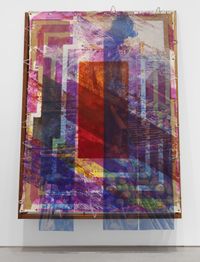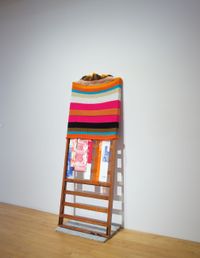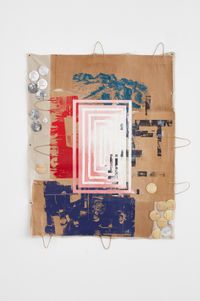Formal experimentation and institutional critique are combined in American artist Tomashi Jackson's research-driven practice, which visualises systemic racism and policy failure facing underrepresented communities in the United States.
Read MoreBorn to a photographer mother in 1980, in Houston, Texas, and growing up in Los Angeles, Tomashi Jackson was surrounded by film and images from an early age. She began making her own, and later studied photography and printmaking at Copper Union in New York (2006–2010).
Jackson went on to earn an MS from the School of Architecture and Planning at Massachusetts Institute of Technology in 2012, followed by an MFA in Painting and Printmaking at Yale in 2016, with further studies at Skowhegan School of Painting and Sculpture in Maine in 2019.
Predominantly in painting, textile, video, and sculpture, Jackson's bold compositions are known to layer archival photographs, found materials, and text, often distorted by scribbles and bright geometric shapes that allude to the categorical language of law and policy.
Jackson became interested in Josef Albers' research on colour relativity while studying at Yale, noting similarities in the language he used to describe colour perception and that of racial segregation in court documents and educational policy of the United States.
This parallel prompted her to use colour theory as a starting point to investigate systemic racism, beyond racial categories that are only reinforced through wording, and inspired the 'exuberant colour, bold geometry and intricate layering of materials' within her work today.
In Upright, Colored, and Free (2007), a ladder in a rainbow sweater takes on the appearance of a painter's easel. Along its surface, photographic strips of a young girl's face nod toward unrestricted youth, while the marble tile below it—a material tracing back to ancient civilisations—recalls the challenges of institutionalised art as a means of liberation.
Migration and the restricted movement of POC is a recurring interest in Jackson's work. At the 2019 Whitney Biennial, Jackson showed three semi-abstract, mixed-media paintings that layered photographs, found materials, and texts to visualise stories of disposessment and displacement in New York.
In Third Party Transfer and the Making of Central Park (Seneca Village—Brooklyn 1853–2019) (2019), an orange storefront awning—a recurring object in her work—fixed to the wall featured densely layered photographic strips that recalled events in local history.
Jackson compared current homeowners in Brooklyn losing their homes due to policies favouring local developers to 19th-century cases of displacement, during which POC were pushed out from their neighbourhoods to make space for Central Park.
More recently, Jackson was invited to explore these themes at Parrish Museum, New York, resulting in The Land Claim (2021), which featured paintings, photography, archival materials and sound based on interviews with Black, Latinx, and Indigenous communities on Long Island.
Centring their past and present experiences, Jackson discussed issues of labour, land, and matriarchy with local educators, artists, historians, and community advocates, the audio of which was presented in the multi-channel sound work The Interviews (2021).
Shown alongside were six large-scale paintings in the artist's signature style and a photographic triptych of three enlarged images provided by her interviewees, titled Vessels of Light (2021), which depicted members from their family and moments of coming together.
In Among Fruits (Big Shane and the Farmer) (2021), soil from the Parrish Art Museum grounds (a former potato field), paper potato bags, and paper bags with archival prints layered on a purple-toned canvas reveals the glimpse of a woman's face, attesting to Jackson's penchant for material expressions.
Tomashi Jackson is the recipient of the 2022 Roy R. Neuberger Prize and the 2020 Joan Mitchell Foundation Painters and Sculptors Grant.
Tomashi Jackson's work has been shown widely in the United States.
Select solo exhibitions include: Tomashi Jackson: Across the Universe, Museum of Contemporary Art, Denver (2023); SLOW JAMZ, Neuberger Museum of Art, New York (2022); The Great Society, Tilton Gallery, New York (2022); The Land Claim, Parrish Art Museum, New York (2021); Love Rollercoaster, Wexner Center for the Arts, Columbus (2020).
Selected group exhibitions include: Going Dark: The Contemporary Figure at the Edge of Visibility, Solomon R. Guggenheim Museum, New York (2023); What Is Left Unspoken, Love, High Museum of Art, Atlanta (2022); Working Thought, Carnegie Museum of Art, Pittsburgh (2022); New Light: Encounters and Connections, Museum of Fine Arts, Boston (2021); Slowed and Throwed: Records of the City Through Mutated Lenses, Contemporary Arts Museum Houston (2020); Whitney Museum of American Art, New York (2019); and Museum of Contemporary Art, Los Angeles (2018).
The artist lives and works in New York and Cambridge, Massachusetts.
Tomashi Jackson is represented by Pilar Corrias, London; Jack Tilton Gallery, New York; and Night Gallery, Los Angeles.
Elaine YJ Zheng | Ocula | 2023






